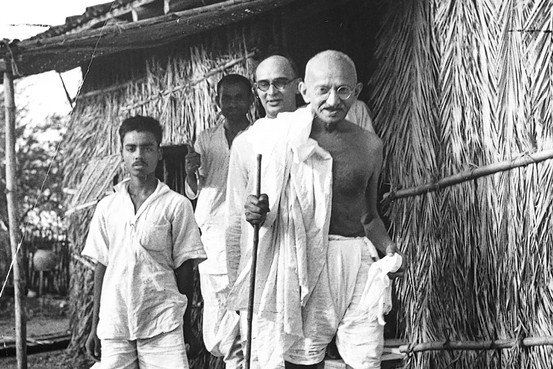Mahatma Gandhi is perhaps one of those thinkers and visionaries whose contributions and articulations on themes as varied and diverse as politics, law and governance, spirituality, education, economics or even education have been throughly debated, discussed and applied in different corners of the world even long after his passing.
While Gandhi as a political leader, spiritual seeker and an educationist has been visited often in the later years, his contributions as an environmentalist become very important for the contemporary world where the crisis around ecology is one of the greatest challenges faced by the world.
Gandhi’s environmentalism is engrained in his overall vision and design for India and the world and cannot be seen in isolation from either his politics or his spiritual quest. At the core of his environmental vision was the idea that humankind should only extract from nature what it cannot do without or only the absolute necessary for human sustainability.
Gandhi looked at the practices of the ecologically sensitive communities such as the tribals and the peasants as more in tune with the needs and nurturance of the environment and problematised the advent of modern industries as a process that looked at nature more as utility than with gratitude. Gandhi’s environmentalism is closely associated with his ideas on polity, development, economy.
It is then no surprise that even in independent India many environmental movements like Sunderlal Bahuguna initiated Chipko or Medha Patkar led Narmada Bachao movements have drawn an inspiration from him but since Gandhi’s concerns were much broader than can be fitted within a select domain of activism to include areas as wide as social-political reform, development, untouchability and even economic concerns, we cannot say that Gandhi looked at himself solely as an environmentalist or an analysis of his statements and writings will establish him as one.But what we do know for sure is that although commonly used terminologies in contemporary environmental studies such as ‘ecology,’ ‘climate change’ or ‘environmentalism’ do not feature in his writings and public addresses, environmental sustainability was critical to his engagement with politics and spirituality, crucial to which were his ideas for striving towards a way of life that was ecologically sustainable.
The last five decades have seen an unprecedented growth in the environmental consciousness but if one looks at folk cultures, traditions and even ways of livelihood in the non-modern tribes and communities one realises that they have largely had a reciprocal, mutual relationship rather than a utilitarian one of reckless exploitation.
Humans and environments have been understood to be in continuum rather than as fragmented and compartmentalised into never-meeting entities where the later is solely meant for the former’s consumption. Gandhi’s body of work shows that for him even apparently diverse and distinct aspects such as politics and spirituality, development and social reform, communalism and environmentalism were interrelated. His mind then became a blank canvas where economics, politics, educational ideas, social reform and environmentalism fuse into one another as different colours and paint a spectacular scenery. What guided his layered and complex mental landscape was a thread of ethics informed by the philosophy of non-dualism. Therefore if Gandhi’s views on environmentalism are be understood they cannot be seen in isolation to his ideas on society, politics and economics. Gandhi reiterated that life isn’t to be divided into fragments or compartments and that inclusivity and not exclusivity is the key for outer as well as inner bliss.
In our indigenous or traditional knowledge systems there is an emphasis on holism rather than compartmentalisation. Although many issues that form the mainstay of environmentalism such as climate change, deforestation, ecological pollution and concerns around natural resources were not prominent during his lifetime, his critical reflections on an industrial civilisation issued a warning against much of the crisis that we face today.
It is remarkable that Gandhi’s understandings of the malaise of modern capitalism was so well built that he predicted most of the environmental concerns that we are facing today and perhaps that is why today there is a growing discussion around the world on the relevance of his insistence on the ‘basic model of living.’
Gandhi warned that while the modern capitalist world created mental restlessness and the need for excess, but needs are to be limited and resources to be shared. The ideal of endless wants and desires is destructive and forms a delusion, warning us of the perils of reckless development and industrialisation. Modern civilisation for Gandhi premised itself on reckless exploitation of nature and fellow beings and he could for see what a global race towards such a trend could bring in terms of disasters and exploitative regimes. Gandhi took a lot of inspiration from Jainism where nature was seen as a living entity and a life of minimum needs was central, was deeply inspired by Tagore’s vision of an ecologically sensitive education at Shanti Niketan and felt in tune with his western counterparts like Thoreau, Ruskin. These thinkers formed the backbone of a critique of modern industrialisation and influenced Gandhi to chart out a philosophically and ethically enriched environmentalism premised on the basic needs model. Primary to this model was to establish a respectful and reciprocal relationship with nature rather than an exploitative one and for him the minimisation of needs, abstinence from greed and ethical understanding were important.
Gandhi remained an ardent critique of wastefulness, greed, hoarding and exploitative and unethical engagements with nature and warned that nature produced enough for everyone’s need but not to gratify everyone’s greed. He was interested in the study of indigenous medicine and knew a great deal about the medicinal properties of plants. His assertions for a village model of economy where local artisans, peasants and traditional knowledge systems thrived and a critical view of machinery and industrially produced items indirectly indicate at his focus on ecological sustenance. His own Ashrams were built with ecologically sensitive and traditional architectural designs, his major movements and historic contributions whether in the form of Dandi March or in 1946 his walk through the burning lanes of Noakhali showed that he wanted to live and die as close to people and nature as possible. Gandhi stood for locally produced, village based technologies and central to his vision was Charkha because it didn’t take the place of a human but only aided him in his activities. When Gandhi defined technology as man-aiding rather than disabling/replacing element it highlighted how central the human-nature balance was for him. Gandhi through his life and writings identified the root cause of the contemporary environmental problems and gave us viable and ecologically mature solutions to them. He showed how simple living and minimisation of needs was crucial and his vision for a self-reliant and rurally empowered civilisation in the absence of exploitative industrialisation and atomisation could help create a harmonious relationship with nature. From Gandhi’s lifelong emphasis on non-violence, self-reliance, non-duality and ethics it becomes clear that Gandhi’s environmentalism is engrained in all that he did and stood for throughout his life.
Ananya Pathak, Associate Editor, The New Leam.












